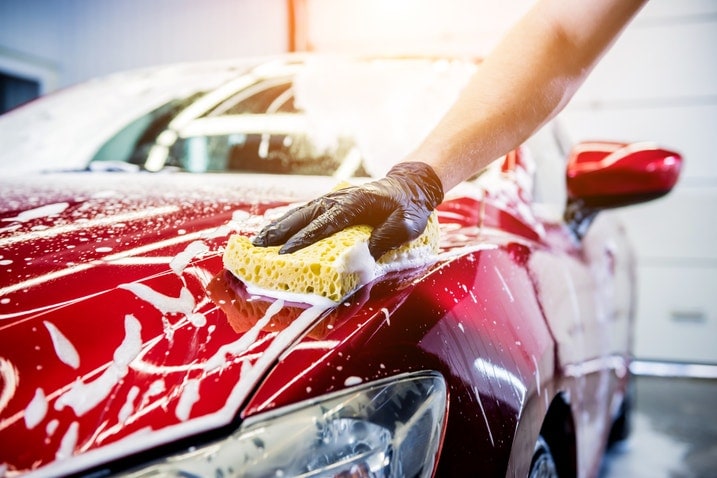Photo by romaset | iStock
Whether you drive a top-of-the-range sports car, a dependable family SUV or a practical sedan, keeping your vehicle clean will help to preserve its value and keep it looking its best. While washing a car may seem like an easy task, there are many ways to get it wrong and potentially damage the look of your vehicle.
In our comprehensive guide to washing a car, we take an in-depth look at the steps involved and the benefits of regular washing, including making a great impression while protecting your investment.
Preparing to wash your car
Washing your car doesn't need to be a chore. It's a great excuse to get outside and enjoy the fresh air and sunshine. In fact, the simple act of keeping your car clean can be a therapeutic experience, especially when you stand back and admire the results of your hard work.
You don't need to invest in state-of-the-art car cleaning products to get a nice finish. While you can achieve a gleaming finish with prewash, car shampoo, glosses and waxes, you can get excellent results with just a good cleaning solution, a wash mitt, and a bucket of water.
Like many manual tasks, the secret to successful car washing lies in the technique. Before we get into the details of how to wash your car, let's look at the supplies needed to make the process smooth and efficient.
Gather your supplies
Make sure you have everything at hand before you begin. Here's the checklist:
Bucket of water: You need at least two buckets — one for soapy water and one for rinsing.
Wash mitt: A microfiber wash mitt is gentle on your car's paint and effective in removing dirt.
Wheel brush: This is a specialized tool for cleaning wheels without scratching them.
Cleaning solution: Use a wash soap designed for cars; avoid dish soaps since they can strip wax and damage the paint.
Choose a shady spot
Wash your car in a shaded area to prevent water spots and soap from drying too quickly, which can make the cleaning process harder and less effective. If you choose to wash your car beneath the shade of a tree, be sure to move it afterward to avoid opportunistic birds from ruining your handiwork. Beyond being unsightly, bird droppings can contain acids that could damage your car's paint.
Washing your car
The exterior of your car is the area that often accumulates the most dirt and grime. From dust and bird droppings to mud and road salt, these contaminants can spoil the appearance of your car and need to be removed regularly. Properly washing the exterior enhances the vehicle's appearance and protects the paint from damage. Follow these steps to ensure a thorough clean:
Rinse the car. Start by rinsing your car with plain water to remove loose dirt and debris. This initial rinse is important as it helps prevent scratches and swirls when you start washing with soapy water. Use a hose or pressure washer for a thorough rinse, ensuring all loose particles are washed away.
Apply soapy water. Mix the car wash soap with water in your bucket according to the instructions on the bottle. After dipping your wash mitt in the soapy bucket, gently wash the car in sections. Begin at the top of the car and work your way down to avoid dragging dirt from the lower parts of the vehicle across the cleaner, upper sections. Rinse the wash mitt frequently in your second bucket of water to reduce the risk of contaminating your paint, then dip the rinsed mitt back in the soapy bucket and resume washing. Use gentle straight-line motions rather than circular scrubbing to minimize the risk of scratching the paint.
Clean the wheels. The wheels often collect the most dirt and grime, including brake dust that can be particularly stubborn. Use a wheel brush to scrub the wheels thoroughly. Make sure to rinse the brush frequently in a separate bucket to avoid spreading brake dust and debris back onto the wheels. Pay extra attention to the inner parts of the wheels and any crevices where dirt can accumulate.
Rinse and dry. After washing, rinse the car thoroughly with plain water, ensuring all soap is removed. Dry the car with clean, dry towels or clothes to avoid water spots. Microfiber towels are highly recommended to get the best finish.
The importance of regularly washing your car
Regular washing removes contaminants, such as bird droppings, road salt and tree sap, that damage your car's paint and finish. It also allows you to inspect your vehicle for any issues that might need attention.
Here are just some of the benefits of washing your car regularly:
Protect the paint. Regular washing prevents dirt and contaminants from embedding in the paintwork and trim.
Maintain value. A well-maintained car with a clean exterior is more likely to retain its value.
Enhance appearance. A clean car simply looks better and can provide a sense of pride and satisfaction.
By following these steps, you can keep your vehicle looking great and ensure it remains in top condition for years to come. It doesn’t matter if it’s a sunny-day sports car or a dependable daily driver — taking the time to wash your car properly pays off both in terms of appearance and long-term care. Remember, a little effort in washing your car goes a long way in protecting your investment and showcasing your pride in ownership.
